|
FAQs on the Rainbowfishes Health/Disease 2 Related Articles:
Rainbowfishes,
Fishes at the rainbow's
end;
An
introduction to the Atheriniformes, the Rainbowfish and
silversides by Neale Monks
Related FAQs:
Rainbow Disease 1,
Rainbow Disease 3, Rainbow Disease 4,
Rainbowfishes 1,
Rainbowfishes 2, & FAQs on:
Rainbow Identification,
Rainbow Behavior,
Rainbow Compatibility,
Rainbow Selection,
Rainbow Systems, Rainbow Feeding,
Rainbow Disease,
Rainbow Reproduction,
|
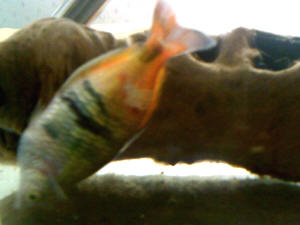
|
I bought Marci (Marcii sp?) Rainbowfish and got the wrong
information... hlth. 7/17/16
Thank you for taking the time to read this. I'm sorry if it's a little long, I
would just like to explain my situation as best as possible.
<Sure.>
I bought a dozen Marci Rainbowfish about 8 months ago, which I was told were
full grown adults, they were all 3.5" to 4" when I got them. They are now 5" or
6".
<Marci Rainbowfish are hybrids, based on Melanotaenia parkinsoni I think, and as
such a bit unpredictable in terms of size and colouration. But I certainly
wouldn't expect any non-dwarf Rainbowfish to be particularly small. So the size
of the specimens you have sounds perfectly normal.>
I believe there are about four males and eight females, although it is possibly
six of each. I have never seen even the slightest aggression between them.
Shortly after I purchased them they all got sick. They had white fuzz on their
lips, open sores and Ich. I thought for sure it was Columnaris or Fish TB.
<Probably the former; Rainbowfish are a bit prone to Columnaris, which is easy
to treat if caught early on, usually using standard Finrot medications.>
I did daily water changes (except for when I was dosing meds) and expected to
lose all of them, plus my fish in all other tanks because of any
cross-contamination I may have caused. After 4 weeks of trying parasite, fungus,
and Columnaris meds, I hadn't seen any improvements. Someone at my lfs had
suggested Artemiss and Herbtana which I used for the next two to three weeks and
even started overdosing out of frustration.
<Not a massive fan of "herbal" remedies, which tend to be unreliable, at best.>
They slowly started healing and eventually all recovered and I didn't lose any.
All twelve have been healthy since.
<Good.>
I had them in a 40 breeder and I just upgraded them to my lightly planted 55
gallon setup where the whole mid and top is an open free swim area for them. I
rehomed all of the fish that were in that 55gal except for 6 emerald Corys. I
also added the 280gph canister from their tank to the 280gph canister that was
already on the 55 so I am 10x filtered. I have 2 x 48" LED mid range planted
tank lights that I usually have on 8-10 hours a day and then and the blue
moonlight most of the time for the rest of the night.
<Understood.>
I do a 50% water change every 10 days on that tank. The only problem being that
the nitrates are usually closer to 20ppm than I would like, but I had been
overfeeding because of the picky discus, that had lived in the tank previously.
My Corys and apple snails couldn't get all of the scraps apparently so I have an
outrageous MTS outbreak that I am wrestling with.
<Don't wrestle. They're harmless, and multiply according to the amount of
uneaten food and decaying organic material available. Reduce these, and the
snails die back to less obtrusive levels. Assassin Snails can be a useful
control. Worst case scenario, empty the tank replace the substrate entirely, and
remove any visible snails. A few will remain in the filter, but adding Assassin
Snails should prevent them becoming a problem again *if* you minimise the amount
of organic muck in the tank that the snails can eat. Whatever you do, don't use
snail-killing potions.>
They Marci's don't seem happy. They school very tightly and generally stay in
one section of the tank. They aren't utilizing the 48" length at all. I know
they should be in at least a 72" tank, but I just can't do that anytime soon.
The store that I usually give my fish to won't take them because they don't deal
with rainbows for some reason and large freshwater tanks don't seem to be a
common hobby in my local area.
<Curious.>
Is there anything I can do to make them even slightly more comfortable?
Create a lengthwise current for them to swim into so it gives the illusion of
more swimming space? Go from slightly to moderately or to heavily planted? Feed
them live foods?
<Rainbows prefer shady tanks but with plenty of open swimming space, so surface
vegetation is a plus, whether floating plants or long strappy leaves such as
Vallisneria. Check the substrate isn't some vivid colour that's stressing them
(some folks go for red and blue gravel for example, which most fish don't like).
Ordinary gravel or black sand are the ideal.
They don't need a huge water current, most actually come from relatively still
habitats, so moderating the current can be worthwhile if you have a very strong,
turbulent flow from the two filters. They are "prey" fish as well, and don't
tolerate aggressive or territorial tankmates well, so review what's in the tank
with them. Big cichlids can cause problems, for
example. Also review water chemistry. Rainbows are adaptable, but they don't
like very soft/acid conditions, and will be happier in neutral to slightly
basic, medium hardness water. Last but not least, they need time to settle down.
If they've experienced a lot of changes recently, they may need a while to
settle back into their home. You don't seem to be doing
anything particularly wrong, and a 55-gallon system should be adequate for a
dozen Rainbowfish plus a few well-chosen tankmates.>
I do feel terrible that they don't have more room. I would appreciate any advice
on how to make this tank as good of a home for them as possible, given the size
restrictions I'm working with.
<Hope this helps, Neale.>
|
Threadfin Rainbowfish with mystery ailment
1 1 16
Hello crew!
<Car>
2nd try here; the first email I sent got rejected as spam.
<Argghhh. Actually likely our email program being too overloaded w/ too large
pix!!!>
I have removed the two images that are mentioned later on. I can certainly
re-send if needed, though I think they should be sitting in your spam folder.
<Mmm; no. All would have been refused. Please re-size and re-send as a few
hundred Kbyte files>
I have a tank of threadfin Rainbowfish with a mystery ailment I just can't pin
down.
I've read quite a few great articles from your site, and I was wondering if you
all might have any ideas in this case. Your help is much appreciated!
The tank is a 25 gallon cube, in operation for about 10 months. It is heavily
planted (dirt substrate, capped with sand/fluorite mix). I run sporadic DIY co2,
and occasionally fertilize macros and micros. Ammonia is 0, nitrite is 0, and
nitrate is generally <10ppm due to the high plant load. (I often test 0 nitrates
- oops, time to fertilize!) PH is around 7.4, temp is 77. I have water lettuce
and extra-long Vallisneria providing overhead cover for the fish.
The rainbows are the only fish, although they share the tank with an uncountable
number of cherry shrimp, a couple Nerites, and Malaysian trumpet snails. At one
point, I had a school of 20 (15 females, 5 males), but am now down to 11. They
die off VERY slowly - I can tell a fish is a goner for weeks before their death,
if not more. They continue to eat and school up until the end, although as their
time draws near, they feed/school less assertively, if you will. They seem to
lose weight over the back; I can occasionally detect very subtle hollows behind
their head along their top line. They fade in color every so slightly (they'll
be a slightly grey-er shade, less yellow-y) and look very, very slightly
"rough," although none of this would be readily apparent to a casual observer. A
few have had trailing, mucous-y feces. Two had prolapsed rectums within 48 hours
of each other. I think one of these has since un-prolapsed (but sometimes it's
tough to tell my remaining females apart).
<Mmm; am tempted to guess now... that this is some sort of internal protozoan
issue... would lace foods with Metronidazole>
I have tried Kanaplex and Praziquantel with no success. The real reason I write
you is this: I just had another female kick the bucket, and decided to perform
an amateur necropsy with my microscope in the hopes of seeing evidence of a
parasite.
<Great!>
I have attached two images.
<Do please send these along>
One is from feces, where the only oddity I found were some segmented structures.
If you can make them out, they had between 6 - 12 segments. They were all over
her poop. None were moving. I also looked at her organs (the second image), and
one organ (kidney? swim bladder? I couldn't tell…) was just covered in black
star-shaped splotches. Her other organs (stomach and GI tract, I think) had a
few similar blotches, too. Both attached pictures are at 40x magnification. I
can't find anything on the internet that is a dead-ringer for either the
segmented things or the liver-blotches.
Well, I think I remembered everything I meant to include. Any ideas at all?
Thanks for the help!
Sincerely,
Carrie
<Cheers, Bob Fenner>
Threadfin Rainbowfish with mystery ailment /Neale's try
1/2/16
Hello crew!
<Carrie,>
2nd try here; the first email I sent got rejected as spam. I have removed the
two images that are mentioned later on. I can certainly re-send if needed,
though I think they should be sitting in your spam folder. I have a tank of
threadfin Rainbowfish with a mystery ailment I just can't pin down. I've read
quite a few great articles from your site, and I was wondering if you all might
have any ideas in this case. Your help is much appreciated!
The tank is a 25 gallon cube, in operation for about 10 months. It is heavily
planted (dirt substrate, capped with sand/Fluorite mix). I run sporadic DIY co2,
and occasionally fertilize macros and micros. Ammonia is 0, nitrite is 0, and
nitrate is generally <10ppm due to the high plant load. (I often test 0 nitrates
- oops, time to fertilize!) pH is around 7.4, temp is 77. I have water lettuce
and extra-long Vallisneria providing overhead cover for the fish.
The rainbows are the only fish, although they share the tank with an uncountable
number of cherry shrimp, a couple Nerites, and Malaysian trumpet snails. At one
point, I had a school of 20 (15 females, 5 males), but am now down to 11. They
die off VERY slowly - I can tell a fish is a goner for weeks before their death,
if not more. They continue to eat and school up until the end, although as their
time draws near, they feed/school less assertively, if you will. They seem to
lose weight over the back; I can occasionally detect very subtle hollows behind
their head along their top line. They fade in color every so slightly (they'll
be a slightly grey-er shade, less yellow-y) and look very, very slightly
"rough," although none of this would be readily apparent to a casual observer. A
few have had trailing, mucous-y feces. Two had prolapsed rectums within 48 hours
of each other. I think one of these has since un-prolapsed (but sometimes it's
tough to tell my remaining females apart).
I have tried Kanaplex and Praziquantel with no success. The real reason I write
you is this: I just had another female kick the bucket, and decided to perform
an amateur necropsy with my microscope in the hopes of seeing evidence of a
parasite. I have attached two images. One is from feces, where the only oddity I
found were some segmented structures. If you can make them out, they had between
6 - 12 segments. They were all over her poop. None were moving. I also looked at
her organs (the second image), and one organ (kidney? swim bladder? I couldn't
tell…) was just covered in black star-shaped splotches. Her other organs
(stomach and GI tract, I think) had a few similar blotches, too. Both attached
pictures are at 40x magnification. I can't find anything on the internet that is
a dead-ringer for either the segmented things or the liver-blotches.
Well, I think I remembered everything I meant to include. Any ideas at all?
<The short answer is don't keep Threadfins. Or at least, don't buy from this
supplier. That's not necessarily a judgment on the quality of their livestock
(though these fish travel poorly and are easily starved by inept maintenance)
but can be a reflection on where they've been collected (there are several
geographical forms, differing not just in colouration but also in the ambient
water conditions they enjoyed in the wild). As Bob suggested, treating with
Metronidazole, alongside an antibiotic, is a good move when quarantining these
fish -- which is absolutely what you should be doing if at all possible (at the
very least, introduce into their own tank to begin with, then once settled and
putting on weight add tankmates). Deworming not a bad move either. Alongside all
of this, be super-critical of your pH and hardness situation. While the whole
CO2 fertilization thing is grand for keeping plants, if pH changes a lot, and
the CO2 reacts with dissolve carbonate hardness, that can cause problems for
certain types of fish. DIY CO2 fertilization is not something I'm personally
comfortable with. An automatic dosing system, ideally one that stabilised pH so
far as practical, is a much better move. Conversely, simply leave the CO2 for a
few months and see if that affects your success. Threadfin Rainbows aren't
impossible to keep, but they are sensitive and delicate, they are extremely
greedy fish -- easily starved, but easily overfed too -- small meals, but
frequent ones is best, in keeping with a typical zooplankton feeder. Try some
energy-rich supplements to flake foods, for example lobster eggs, and see if
they'll take these. You can buy them frozen from marine aquarium shops. Do also
review aeration; CO2 displaces dissolved oxygen, and this can cause severe
stress for non-air-breathing fish like these. I'm not wild about cubic tanks
because of their poor surface area to volume ratio, but all else being equal, a
25-gallon tank should be more than adequate for a school of Threadfins. Do you
know ANGFA? I'd spend some time on their website and consider joining their
forum. These guys know A LOT about Rainbows!
http://rainbowfish.angfaqld.org.au
http://forums.angfa.org.au
I've worked with some of the guys there, and they've always been very helpful.>
Thanks for the help!
Sincerely,
Carrie
<Cheers, Neale.>
Re: Threadfin Rainbowfish with mystery ailment
1/2/16
Hello Mr. Fenner,
<Hey Car>
Thanks so much! I have tried re-sending the 2 pictures here. The first picture
is 58KB and the second is 162KB. I've actually sent them one at a time just in
case. I'm very curious - I just have a hunch that someone with
veterinary expertise is going to look at my "black blotches" picture and know
exactly what I'm seeing in there.
<The star like dark objects are melanophores; black pigmented color cells>
As an aside, I happen to have a big bottle of Metronidazole pills leftover from
when a horse needed them. They are easily crushed into powder, though a bit out
of date. Think they might work?
<Yes; a one shot only treatment>
Happy New Years, and thanks again.
Sincerely,
Carrie
<And you, BobF>
|
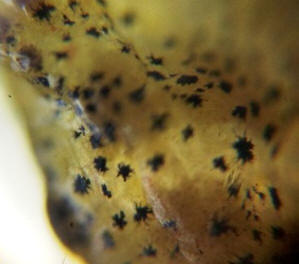 |
|
Re: Threadfin Rainbowfish with mystery ailment
1/2/16
Hello Mr. Fenner,
Here is the second image - attached.
<I have cropped and optimized part of the field of view here; showing segmented
items.... are these food artifacts? BobF>
Sincerely,
Carrie
|
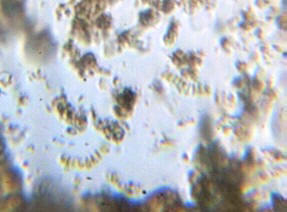 |
|
Dwarf Rainbow sick... no data, reading....
11/25/15
<Tam: 13.5 megs of the same pix three times? WHY? And why do we limit file size?
http://www.wetwebmedia.com/wwmadminsubwebindex/question_page.htm>
Hello,
I looked all over your site and couldn't find anything related to my situation.
My Dwarf Rainbow fish is kinda bloated and whitish belly(maybe due to bloating).
She is eating fine and swimming great. I am just afraid if I don't figure out
what is wrong with her she will pass. I did try peas and she ate them but still
bloated. I am attaching pictures so you can see, they
are not the best in clarity but I think you can see what I am seeing with the
bloating.
I have had this tank up and running for 2 years with no issues. Feed them a mix
of dried Thera +A, spectrum grow, brine shrimp, daphnia.
Water quality is great. I have an RO system
<What water quality values/test data do you have?>
and neutral regulator is added when doing weekly water changes to new water. I
also heat water to tank temp before adding it as well.
Any help would be greatly appreciated.
<READ here:
http://www.wetwebmedia.com/fwsubwebindex/rainbowdisf.htm
and the linked files above. Bob Fenner>
Sincerely, Tammie
|

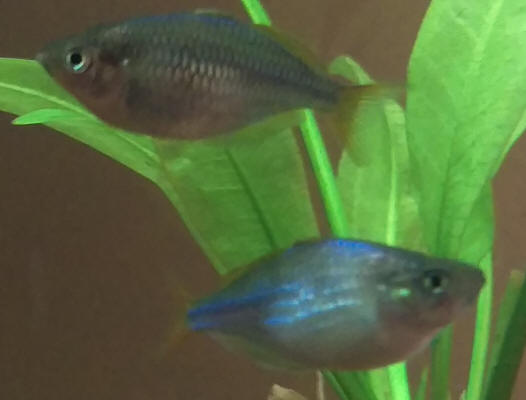 |
|
diseased Rainbowfish?? 7/3/15
Hi I bought 6 neon Rainbowfish (all male)
<Better to have a mix; mostly females.... for behavior and health reasons>
for my 55 gallon tank two days
ago. Other inhabitants include 1 Firemouth, 1 Krib, 6 tiger barbs, 1 BN Pleco
and a variety of plants. Temp of tank is 80F and I use flourish and Osmocote
tabs for ferts. Parameters: 0 ammonia, 0 nitrite, nitrate 20-30.
<Any test for free iron, phosphorus?>
Over night one of the Rainbowfish turned white on top of his head and down his
back. I haven't noticed any other symptoms because I had to leave for work. He
was still pestering some of the other Rainbowfish, he is the biggest one in
there I believe. I have no idea if this is a disease or physical injury,
<More likely the latter; but most likely just normal male-male behavioral color
expression.>
I've never seen anything like it. Could he maybe have jumped out of the water in
the night and scratched his scales off on the hood?
<Yes; quite common>
I don't know what to think. Thank you so so much for your help!
<More cropped pix/pic would help here. Just good care (stable, optimized
conditions and good nutrition) and time going by here for a cure. Bob Fenner>
|
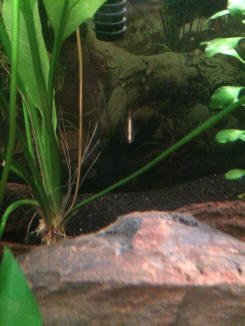
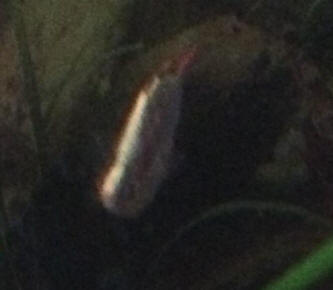 crop crop |
Boesemanni rainbow w/ ich; treating tank w/ hyposalinity?
2/24/15
Hello Bob et al. from snowy Chicagoland!
<Brrr; was at O'Hare two wknd.s back on the way to GIRS, Iowa... six F...>
I just discovered that my single Boesemanni rainbow has come down with ich.
Currently he resides in a 44 gal heavily planted well established tank with one
Siamese algae eater and one juvie albino Bristlenose Pleco. No ammonia, nitrites
or nitrates, need to check pH and temp. There are also probably 3-4 small cories
in the tank, not sure on the number because I never see them!
<Mmm; the plants and Corydoras make simple temp. elevation route more difficult,
but this IS still the route I would go>
I am wondering if I can treat the tank w/ aquarium salt with the inhabitants as
listed below. Any other suggestions?
<85 F, NOW>
I'd greatly appreciate a bit of help here. I've been fortunate to not have a
sick fish for years so much of what I previously knew is buried somewhere in the
great recesses of my brain;)
Many thanks, Jorie
<Cheers and hello to Chris. BobF>
Re: re: Boesemanni rainbow w/ ich; treating tank w/ hyposalinity?
2/24/15
Done and done. Chris says hello too!
How long to treat with raised temperature in this fashion?
<Ahh; please read here:
http://wetwebmedia.com/FWSubWebIndex/fwichremedyyes.htm
Thanks again,
Jorie
<Sound familiar? Heeeee! B>
Re: re: Boesemanni rainbow w/ ich; treating tank w/ hyposalinity?
2/24/15
Very good, gracias!
<Poor Ralph Nader! B>
Only two rainbow fish left
11/10/14
Hello:
I have a question about Turquoise Rainbow fish. I have two left in a 75 gallon
with three angelfish that are laid back. When someone has only two of a
schooling type of fish should they give them away as they maybe
stressed at that number or buy a few more reduce stress??
<It's an age-old question in the hobby! Probably depends upon the species.
Some are so nervous and shy that it's unfair to keep them singly. Neons, for
example. Others are bolder, and may even become quite aggressive when kept
singly, and whether they do harm depends upon their tankmates. Danios often fall
into this category. Yet others will mooch about with non-identical species if
they're feeling lonely. Rainbowfish species often mix like this. So, if your
Rainbows are basically happy and feeding, don't
go into shock at the slightest thing, and aren't harassing their tankmates, you
could justifiably choose to leave them in place. Rehoming them is risky if the
next person keeps them badly, so it's one thing giving to a pal that
has Rainbowfish they could school with, but something else taking them back to
the pet shop. When all is said and done though, if you have the option of adding
three or four more, then yes, that'd be best (though there is a
small risk even here, that male Rainbows might bully each other, so getting more
females than males is always the better option). Cheers, Neale.>
Regarding: Bout of swordtail deaths and Ill rainbow?
10/29/14
Dear crew,
<Bryan,>
First of, thank you for the site and it's resources. I have a metre
square but a foot high pond that houses a number of stock that I am not
entirely able to keep track of due to it's semi planted nature.
<Sounds a lot of fun!>
The primary issue is that there have been a bout of swordtail deaths,
though I suspect that it could be due to the end of their natural
lifespan?
<Possibly; farmed fancy Swordtails seem to last 2-3 years these days.>
The swordtails have been here for about two years or so. Either way, I
have noticed some injuries on my rainbowfish, which I worry could be
mycobacterium.
<Possibly, and it's impossible to say by looking. It would be sensible
to isolate this fish if possible, medicate as per Finrot and Columnaris,
and see what happens. If nothing improves, humanely euthanise the fish
(30
drops clove oil stirred into a litre of aquarium water works well; leave
it in there for 20 minutes and it'll definitely be dead). Mycobacteria
infections aren't especially common, but they do seem to be a problem
with some species of fish. Since there's no cure, the best and only
approach is to remove and euthanise affected fish before the bacteria
can spread. But with that stated, do bear in mind Mycobacteria are more
or less opportunistic, meaning they become a problem usually when the
fish is stressed.>
I don't exactly have the water readings at this present time but would
you have any idea about the nature of either case or whether they're
connected?
<Could be. Check water chemistry and quality are appropriate to the
species being kept. While deaths from old age and the occasional injury
can be expected, a bunch of sick/dead fish within a few weeks is
definitely worrying.>
Thanks for all your help crew!
<Most welcome, Neale.> |
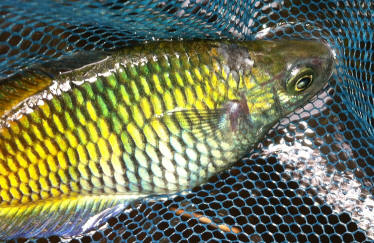 |
Millennium Rainbows Emaciated
7/13/14
Hello WWM! I’m wondering if you can help me out on an issue I’ve been
witnessing with my Millennium Rainbow's I bought five months ago… One
male, one female. Both were roughly two inches at purchase and filled
out well and healthy looking, but now, five months later, as all my
other varieties of Rainbow’s have grown fat and happy, those two have
grown thin, sickly in appearance, and drastically lost color. None of
the other fish display similar issues and the Millennium’s are not
harassed by the other fish. Here is what I currently keep in my 55
gallon tank:
2 millennium rainbows (one male, one female)
2 turquoise rainbows (one male, one female)
3 yellow turquoise (one male, two female)
2 Australian splendida rainbows (one male, one female)
1 Synodontis lace catfish
Stats:
Temp stays at 74 degrees F
Nitrates/Ammonia all ok (regular 30%-50% water changes weekly, as
Rainbows prefer)
PH 7.0
From start-up, I used 4 Neon Blue Dwarf Gouramis and my Synodontis Lace
(whom so desperately needed out of the 30 gallon) to cycle to the tank.
After 3 weeks, I then added all of my above fish, except for the Yellow
Rainbows. Then, after another 2 weeks, I removed the Gouramis (took them
back to the fish store) and picked up the three Yellow Rainbows. During
this time, I only fed Tetra Color flake food to the rainbows and all of
them ate it without issue. It was when I brought home the Yellow
Rainbows, that I began to feed frozen bloodworms. I believe I may have
‘over-did it’ with the bloodworms, as I fed them a cube and a half total
per day, spaced out over three feedings. My ex, (whom was a manager for
a big name fish store in the area for 23 years) scolded me for feeding
them so much, and said I needed to focus more on flake food, and cut
back to feeding one or two times a day. So I did…
But then I noticed that the Millennium Rainbows had no interest in the
flake food, (which became breakfast) and would hold out until I fed the
1/2 cube of bloodworms (which became dinner). They simply shot the flake
food right back out of their mouths, and then began to not even ’taste’
it at all, practically turning their noses up at it, so to speak. I was
told by everyone that they would “come around and start eating the flake
food again”, but even after 4 weeks of this routine, they did not. It
felt all wrong not feeding them like I was before. It was during this
time that I noticed they began getting thinner.
Then, at 9 weeks, I thought that some of my rainbows had developed
'mouth rot’, a white fluffy fungus on their lips. It seemingly bounced
from one fish to another. I first treated with a cheap mainstream fungus
cure, that turned my water a horrendous radioactive green. I used active
carbon after the appropriate time, cleared the tank and waited. The
white ’stuff’ continued to appear randomly on my fish. I was told by the
fish store that my tank was in ‘dire straights’ and needed Seachem
Sulfathiazole. I followed the directions. Nothing changed. Later, I
discovered via the web, that rainbows can damage their lips by bumping
into things, etc. and I took the chance that that was the problem and
stopped dosing my tanks. Lo’ and behold, within 2 weeks, the problem
never worsened and eventually disappeared.
At this point, my tank was 12 weeks old. All fish were doing very well,
but my Millennium’s were drastically thinner, their color gradually
fading, especially in the male. They were the slowest in the tank now,
hovering in the corner together, never moving except at feeding time,
and their poop began to turn clear. I decided to go back to feeding
bloodworms multiple times a day, as I was before, to see if they
fattened back up... But to no avail. I even added beef heart and brine
shrimp on occasion, and still offered flake food for the other fish, and
while they ate whatever I put in the water, the two Millenniums STILL
only ate bloodworms.
Now, I’m at the five month mark, and all the rainbows have grown
exponentially, but the two Millenniums look like ‘death warmed over’.
Their activity HAS increased, as they both now swim with rest of the
school since I went back to feeding them bloodworms more often, but the
once golden female is now a horrid brownish yellow and the once
brilliant red male is a silvery, faded pink. He doesn’t even flare his
fins like he used to, instead opting to keep them laid tight to his
body, making him look almost identical to the female. Their poop now at
least has color to it again, instead of being clear-ish, yet both of
them are an entire inch smaller than all the other rainbows and even
more shockingly thin. The males of my rainbows are all beginning to have
the pronounced ‘big body/little face’ appearance, yet the male
Millennium is still straight and narrow, like a female.
I’m at a loss. Is this common? Do Millenniums have a history of being
picky eaters? What could be causing their emaciated appearance?
I just added another male Millennium today, which is what prompted my
question, because the newcomer is a brilliant red and fat and happy… He
makes my other two look even more like they have one fin in the grave.
And so far, he eats the flake food when offered. None of my other
rainbows show the slightest signs of illness. Where did I go wrong with
those two? Could the medications from before have been a factor? Or is
it an issue with their eating habits?
And am I over-feeding at 3 times per day, with 1 and 1/2 cubes of frozen
food total per day, even though my tank stays clean and balanced? I’ll
take any suggestions or thoughts on the matter at this point. Thanks so
very much for your time.
<Greetings. My gut feeling here is Mycobacteriosis, which is a problem
with Rainbowfish. Not a common one, but a persistent one. The big issue
Mycobacteria is that they're effectively untreatable. You can do quite a
lot to prevent them causing sickness, but once they're there, your fish
are pretty much dead men walking. Mycobacteria are potentially
contagious too, though it's hard to quantify this because environment
seems to trigger Mycobacteria infections that are latent (i.e., there,
but harmless) in aquaria generally, so it's difficult to say if the
second fish was infected by the first or merely succumbed to poor
environmental conditions later than the first fish. Make sense? Worms
are also a risk, as with any tropical fish, but compared to Mycobacteria
they're a lot easier to treat using a proprietary antihelminthic
medication (such as PraziPro) and you might do this anyway, so you can
tick off this possible problem. Anyway, Since your aquarium is
relatively young, evaluating and disregarding environmental factors
causing ill health will be the first step. Rainbowfish are fairly
adaptable, but for the most part they appreciate neutral water that
isn't too hard or too soft, so review water chemistry. Most don't like
extremely of temperature either. Likewise, water circulation should be
brisk but neither sluggish nor turbulent, and oxygenation should be high
(which is one reason not to overstock their tank or keep it too warm).
Diet is always a factor to review; good quality flake is ideal, but as
you seem to realise, bloodworms are kind of like Chicken MacNuggets but
for fish -- readily eaten, but not sufficient by themselves. On the
other hand, underfeeding Rainbowfish is easily done; they seem to have
large appetites and perhaps limited ability to store nutrients, so
frequent small meals are better than one or two big meals. It's also
possible you got a bad batch of bloodworms; indeed, some aquarists I
know refuse to use them at all, citing the conditions they're reared in
as proof enough of their inappropriateness as aquarium fish food. I will
direct you now to the www.rainbowfish.info website, among whose members
is Adrian Tappin, one of the foremost experts on this group of fish.
They may be able to offer you a second opinion. Cheers, Neale.>
|
Spots on Female Boesemanni Rainbow Fish Fin
6/1/14
We brought home a new female Boesemanni Rainbow Fish last week and about 3
days after we brought her home, we noticed that she has some white spots
on
her caudal fin.
<I see these>
They seem to be somewhat iridescent and I cannot find any
information online saying if this is normal for a Boesemanni Rainbow
Fish.
We have 4 other Boesemanni Rainbow Fish and we noticed this morning that
another one has these white iridescent spots on her tail. (All rainbows
are female). We mainly want to make sure this isn't a case of Ich.
<Does appear so... I would simply elevate the temperature...>
This
is out first fish tank. We did not quarantine our new fish since we get
our fish from a very respectable local fish store.
All of our fish are acting normal and all have a good appetite.
Our Ammonia level is 0, Nitrites 0 and Nitrates is around 10. We usually
keep the temperature around 80 F.
<To the mid 80's. Please read here re:
http://wetwebmedia.com/FWSubWebIndex/fwichremedyyes.htm
We do a water change every week. It is
a fully cycled tank about 5 months old.
I have some pictures attached.
--
Thank you,
Stacy
<Welcome. Bob Fenner>
|
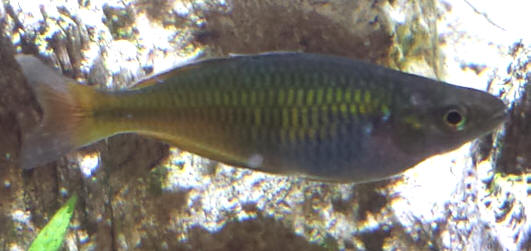
 |
|
Re: Spots on Female Boesemanni Rainbow Fish Fin
6/2/14
So you think the spots is Ich then?
<Likely so>
We are seeing the spots on the other
caudal fins of the rainbows. We did raise the temperature to about 85 F
beginning Friday. How long should we keep the temperature up?
<... please just read where you were referred to. WWM is not a chat forum.
BobF>
We also
have 5 honey gold gouramis, 2 Siamese algae eaters, amino shrimp and
Nerite
snails in the fish tank. It is also a planted tank. We also have an UV
sterilizer. Will that help? When will we know that everything is okay in
the tank?
Re: Spots on Female Boesemanni Rainbow Fish Fin
6/2/14
Sorry. You didn't give me much information with your original response
and I wasn't aware that I couldn't ask anymore
questions.
<No worries>
I did look at the page you referred me to and
it has a lot of conflicting information on it
so I guess I will continue my search.
<Mmm; allow me to addend. I would keep the temp. elevated to a few days
past of when you don't see spots...And of course keep a close eye on all
your livestock... and UVs are useful for providing better water quality,
but will not cure protozoan infestations. B>
|
turquoise Rainbowfish with patches of orange
2/12/13
Hello,
<Kristine>
We have a young turquoise Rainbowfish (about 2") in our 55 gallon who we
thought was a female. However, in the last three weeks it has developed
two large splotches on its forehead that normally look like a dull grey.
In the mornings when we feed, they turn orange just like the stripe on
our bigger male's forehead. Our biggest concern is that it's a fungus
because we have a minor outbreak of mouth fungus that we're currently
treating.
<Mmm, not at all likely a fungus...>
This fish has had no symptoms of that, and its splotches developed about
two weeks before that started. We've been treating with Maracyn Oxy
which so far has mostly cleared up the mouth fungus, but had no effect
on these splotches.
No other fish in the tank (three more turquoise rainbows, two boesemanni
rainbows, and four adolfi Corys) have similar splotches anywhere on
them.
Water parameters are consistently stable at PH 7.4, 0 ammonia, 0
nitrate, 0 nitrite, 74*F, 10 dH. We do a 25% water change once a week
with buffered RO water
<? What re a source of minerals? Needed>
and run two Aqua-Tech 30-60 HOB filters. The tank has been up and running
for almost a year (unfortunately, we are in the process of restocking
after a heater malfunction that brought the tank to 100* overnight). All
things considered, could it be possible that this young fish is a male
and his forehead stripe is developing in splotches? Or is this something
we need to be treating?
<Not>
I have tried to get pictures for you, but those suckers are too fast for
my slow camera phone to capture.
Thanks so much!
Kristine
<Welcome. Bob Fenner>
Re: turquoise Rainbowfish with patches of orange, and only RO water use
02/13/13
Hi Bob,
Umm. Apparently our "trusty" local LFS gave us incorrect information
because we have not been adding anything to the RO water.
<Umm, maybe it didn't dawn on them... fishes, plants, invertebrates...
all to degrees absolutely need mineral content of sorts>
I did some research after I read your email and I'm now confused. We
would like to transition from the bare RO water back to using tap water
due to the expense of remineralizing the RO water. What would be our
best way of doing
that?
<For most cases, simply a routine of gradually adding "just tap" to the
system... make sense?>
We considered using a mix but finding a balance with the PH every time
seems complicated and risky. Please advise! We're tired of getting wrong
info from our LFS and we just want our poor fish to be happy and
healthy.
Kristine
<Do have a read here:
http://www.wetwebmedia.com/FWSubWebIndex/fwhardness.htm
and the linked files above. BobF>
whats wrong with my female boesemanni rainbow? 9/20/12
Good morning,
I have a question regarding one of our female boesemanni. Water 0
ammonia, 0 nitrites, 10 nitrates. PH 6.8 / 7, Temp 26. Two water
changes per week / total 35 to 40%
She is about 18 mths old, is the larger female was a beautiful shape and
colour until about a week ago. She swims in the same spot mid
level, lost weight, not eating, and she appears to have darkened in
colour all over, resembles the colour of a bruised banana. She has
never been bullied, has laid eggs in the past. Doesn't look like
anything external so was thinking internal do these symptoms resemble
anything to you. Here in NZ we cannot purchase medicated fish
food, vets seem non interested in giving us some antibiotics to try. We
have moved her to quarantine, no other fish seem to be suffering from
anything. Please can you advise, we don't want to euthanize if we can
help her.
Many thanks Rebecca
<Have seen this sort of "syndrome" w/ this and other Melanotaeniid
species over the years from time to time, and never a note re treatment
other than spontaneous self-cure. Have wondered at "neurological damage"
from this active species "jumping" and damaging itself on the top, side,
decor... and hence turning dark. Might it be worthwhile to have you read
over the scant info. on WWM, elsewhere on the Web? Bob Fenner>
Re: whats wrong with my female boesemanni rainbow?
9/21/12
Thanks Bob,
She is in the hospital / quarantine tank now, and I did manage to get
her to eat some brine shrimp last night.
<Ah good>
Also persuades the vets to give me some antibiotics to try, though I did
have to pick them up from the normal chemist, thought it wouldn't harm
to try.
<Do ask for a Furan compound, or Oxytetracycline... notes re use are
archived/search-able on WWM>
Yes they can be pretty fast fish, we have had one before that thought
she saw something on the surface and she really hit herself hard on the
glass above. So maybe she did the same thing without us seeing.
<Could well be>
Thank you.
Rebecca James
<Welcome. Bob Fenner>
|
Re: curved spine on boesemanni
rainbow? 3/12/12
Good Morning Bob, still going with the heat and salt hopefully
won't be too much longer..We just have another question for
you regarding our female boesemanni. She has always been a
little different to our other one not quite the same shape, we
thought it may have been because she was younger and had not
developed properly. At first we could see that her lower
half of her body wasn't shapely, kind of flat but over these
past couple of weeks she has grown in Length but her spine is now
crooked.
<I see this>
I have attached a picture for you, you can see her colour
lines are warped to her shape, where our other one who is fine
has complete horizontal lines. Do you think that this is
just a birth defect or could it be something worse (have read TB
can curve the spine)
<Could be Mycobacteria related... nutritional, genetic... a
few other less likely possibilities>
she is eating fine and swimming with the others, though our two
males don't try to flirt with her as they do with the other
one, she swims ok but not quite as graceful but seems happy
enough. Poor Alice, but I do want to make sure she isn't
carrying anything that would be contagious to our other fish,
<Can't tell/say... If this fish appears to be passing,
I'd remove it promptly>
and she hasn't had a white spot on her throughout our minor
outbreak.
Many thanks once again for your time. Rebecca
<Welcome. Bob Fenner>
|
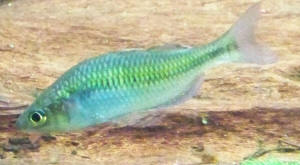 |
Re: curved spine on boesemanni rainbow?
3/12/12
Thanks Bob for your quick reply, when you mean passing I take it
you mean dying?
<Yes Becca; a euphemism>
She doesn't look like she is struggling i.e. not at the
bottom or top of tank, no lethargy or gasping, just doing her own
thing really.
I heard many examples of euthanizing a fish (not something
I'm comfortable with) but in your opinion what methods would
be the least traumatic for the fish.
<Clove oil. Please read here re: http://wetwebmedia.com/euthanasia.htm
Thanks again Rebecca
<Welcome. B>
Re: curved spine on boesemanni rainbow?
Thanks Bob, I will pick some up on my home just in case.
<Real good. B>
Re: curved spine on boesemanni rainbow? Now Colisa
lalia... related deaths?
3/14/12
Good Morning Bob, sorry me again......yesterday afternoon my
husband found one of our Dwarf Gouramis dead at
the bottom of the tank. He was fine when I left for work,
my hubby didn't notice anything strange going on when he came
in for lunch but there he was a couple of hours later dead. There
were no obvious signs beforehand that we could tell, behavior had
been normal, eating fine, no hanging at the top of the tank
gasping or motionless at the bottom. On your very informative
website I had read that these particular fish were prone to a DG
Virus but he displayed none of the symptoms.
<Not always visible>
My husband had a good look at him when he removed him no
sores, no white spot or bloating or anything obvious.
Now as you are aware we are currently going through a small
outbreak with White spot and have had the Heat elevated to 30 for
7 days so far and have been adding the table spoon of salt per 5
gallons with our 25% daily water change, adding the water back at
the tank temperature etc.
checked our water which we have been doing every two days at the
moment, Ammonia 0 Nitrite 0 Nitrate 5 PH 7.4 dh10 kh5. The fish
are fed a varied diet of tetra crisps, shelled peas, cucumber,
zucchini, brine shrimp, blood worms and algae wafers. We tried to
make life easier on the 3 DG'S (with their territorial
issues) by giving them each a hanging silk plant placed in
different areas of the tank which they seem to love.
Could he have died from DG Virus so suddenly with no
symptoms or could it have been our heat and salt from the past 7
days.
<Much more likely the former>
If DG Virus, is it likely the same fate will happen for the other
2, we purchased on the same day from the same store and were all
the same size etc.
<Too likely so, if so>
Many thanks Bob really do appreciate your advice.
Rebecca
<Welcome. BobF>
Re: curved spine on boesemanni rainbow?
3/14/12
Thanks Bob, we will just have to keep an eye on the other two and
see what happens.
Rebecca
<Yes. B>
|
question... FW
stkg. 3/5/12
Hi ,I have a 30 gallon with no salt ,bamboo, sand, a
Madagascar rainbow fish,
<Get more of these first -- they are schooling fish, keep 5+
specimens.>
an albino bristle nose Pleco, banjo cat, and African butterfly fish
<This will eat most small shrimps and suchlike.>
I would like to get something other than a fish (invertebrate or
amphibian)
what would you recommend
<I would not. Amphibians shouldn't be kept with fish at
all, with possible exception of Dwarf Aquatic Frogs that can, with very
great care, be kept with tiny community species like Neons. Among
invertebrates, shrimps will be eaten by the Butterflyfish, unless the
shrimps are rather big, but then your problem becomes keeping the
shrimp from eating the fish! Fan Shrimps are big, but a real pain to
feed, so would not recommend them. Crayfish are far too predatory,
though a Dwarf Crayfish (Cambarellus patzcuarensis) might just avoid
being eaten by the Butterflyfish (I wouldn't chance it though!).
Snails are the obvious option, with the bigger species such as
Tylomelania being fun to watch and rather exciting animals in their own
way. Apple Snails aren't easy to keep, so avoid them. Clams die, so
avoid them too. Crabs are much too destructive and the ones traded are
amphibious and often brackish water anyway, so don't belong in fish
tanks. When all is said and done, I'd recommend choosing one more
fish species to get along with the ones you have, perhaps a personality
species such as a Gourami or a Dwarf Cichlid.>
Sincerely Aaron
<Hope this helps, Neale.>
Re: question 3/6/12
About the rainbow he kind of likes to be solitary. When I
first got him I had another rainbow with him (I inherited him when my
uncles tank sprung a leak) he always nipped and bothered the other, 4
days later I found the smaller one's corpse in a corner with the
other still rainbow nipping at it.
<This is what happens when you keep fewer than six. The dominant
male becomes a bully. Whether or not he killed the other is hard to
say, as most fish will peck at corpses if they're hungry.>
I have put him with Opaline gouramis (one of which died in an
earthquake) and a dwarf gourami. he didn't seem to like them and
often chased them to the bottom. However, he and the butterfly fish
seem to get along and swim together. What fish would you recommend (I
like oddball fish or invertebrates that standout).
<Do read my last message. Invertebrates aren't really an option,
and suggesting fish species is hard without knowing your water
chemistry, water temperature, water quality, and personal experience
level. Something like a Spiny Eel might work, but they're difficult
fish to maintain, and many (most?) die within a year through improper
care. Do read:
http://www.wetwebmedia.com/fwsubwebindex/spinyeelsmonk.htm
http://www.wetwebmedia.com/ca/volume_4/V4I3/Spiny_Eels/Spiny%20Eels.htm
Pay particular attention to diet and substrate. Slightly brackish water
seems to make many Spiny Eels easier to keep.>
Thanks, Aaron
<Cheers, Neale.>
|
white patches on Rainbowfish
1/8/12
hello,
<Curtis, my man!>
Can anyone identify the white patches on my turquoise
Rainbowfish?
<Mmm, broken skin, missing scales from jumping... perhaps
secondary decomposition... bacteria, fungi>
I've attached pictures. They appeared during the quarantine
process, but they were much smaller and I thought they were part
of it's dominance display. They have grown considerably and
have been there ever since(about a month and a half). It's
the only fish that has them and it is the dominant turquoise
Rainbowfish. All the fish act normal and appear healthy.
I have three filters rated at 100 gal each and I do weekly water
changes.
My tank is pretty peaceful, I haven't noticed any attacks on
it. temp. 81, 0 readings for ammonia, nitrate and nitrite,
several pieces of driftwood so ph is probably on the lower
side
<I'd be checking>
current stock:
210 gal. tank
1 male pearl gourami
1 female Koi angelfish
2 female platy
1 discus fish
5 Siamese algae eaters
6 harlequin Rasbora
1 male Geophagus balzani
1 red face gold Severum
1 four line Pimelodella catfish
3 Farlowella
1 dojo loach
1 Synodontis decorus
6 turquoise Rainbowfish
3 red honey gourami
4 red Rainbowfish
1 clown loach
2 bamboo shrimp
1 assassin snail
1 giant African filter
shrimp few plants that my Severum doesn't care for(although
it nibbles on some new growth)
thanks,
Curtis
<Just keep an eye on this fish... should heal on its own. Bob
Fenner>
|
|
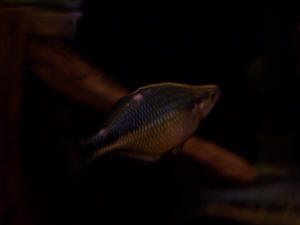
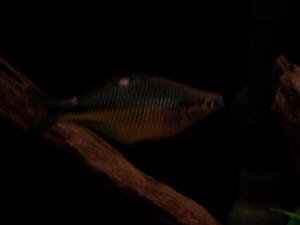
|
|
white patches on Rainbowfish
1/8/12
hello,
<Curtis, my man!>
Can anyone identify the white patches on my turquoise
Rainbowfish?
<Mmm, broken skin, missing scales from jumping... perhaps
secondary decomposition... bacteria, fungi>
I've attached pictures. They appeared during the quarantine
process, but they were much smaller and I thought they were part
of it's dominance display. They have grown considerably and
have been there ever since(about a month and a half). It's
the only fish that has them and it is the dominant turquoise
Rainbowfish. All the fish act normal and appear healthy.
I have three filters rated at 100 gal each and I do weekly water
changes.
My tank is pretty peaceful, I haven't noticed any attacks on
it. temp. 81, 0 readings for ammonia, nitrate and nitrite,
several pieces of driftwood so ph is probably on the lower
side
<I'd be checking>
current stock:
210 gal. tank
1 male pearl gourami
1 female Koi angelfish
2 female platy
1 discus fish
5 Siamese algae eaters
6 harlequin Rasbora
1 male Geophagus balzani
1 red face gold Severum
1 four line Pimelodella catfish
3 Farlowella
1 dojo loach
1 Synodontis decorus
6 turquoise Rainbowfish
3 red honey gourami
4 red Rainbowfish
1 clown loach
2 bamboo shrimp
1 assassin snail
1 giant African filter
shrimp few plants that my Severum doesn't care for(although
it nibbles on some new growth)
thanks,
Curtis
<Just keep an eye on this fish... should heal on its own. Bob
Fenner>
|
|


|
Rainbowfish with curved
spine 8/16/11
Hello, you keepers of fish wisdom. I have a question about an Irian red
rainbow that was given to me last week. He is one of half a dozen
random free fish I found on Craigslist, and the only one to have a
curved spine.
He almost looks like a normal adult male, with the typical humped back,
except his lower half doesn't have the same fullness, so it
accentuates the abnormal curve of his back. Also, his eyes seem larger
than my other rainbows (but not popeyed), but that might just be an
illusion due to the lack of lower-body fullness. Other than that he has
no other symptoms of any illness, he eats like a champ and is very
active. I don't know if his curved spine is due to an illness or is
genetic, or possibly from being in a cramped tank (it looked to be a 15
gallon tall). Either way, he's in a quarantine tank. My question is
this: if he is showing no new symptoms after 4 or 5 weeks of quarantine
would it be safe to add him to my main Rainbowfish tank? I'd hate
to keep him isolated if he's not contagious, since they're
schooling fish, but I don't want to risk my other fish. I also
won't euthanize him, since he's kind of cute in a Quasimodo
kind of way. Can I safely assume it's genetic if he's
symptom-free after a month?
Thanks in advance,
Danielle
<Hello Danielle. This isn't uncommon, and no, his deformities
aren't "catchy". So provided you don't breed from
him, this fish isn't likely to cause you any problems. Deformities
are sometimes genetic, sometimes caused by poor diet or conditions when
the fish was young, and sometimes caused by physical injuries when the
fish was young. Nothing much you can do to help him, and so long as he
can feed and avoid trouble, by all means enjoy this fish in your
community tank. Cheers, Neale.>
|
Dwarf Neon Rainbowfish and Atyopsis
shrimp - disease questions 7/1/11
Hi Crew,
I wrote and liaised with Neale up to last week (VERY helpful),
but now I've got two disease questions (well actually 1.5!)
if that's O.K.
<Fire away.>
Tank vitals as follows:
Tank: 63-litre rectangular, 2 months old, internal power filter
with sponge and ceramic media.
Temp: 27-28 deg C.
Water parameters: pH 7.2, ammonia 0, nitrite 0, don't measure
nitrate (will soon).
Water change regime: 25% weekly, including gravel vacuum.
<All sounds good.>
I recently added a seventh Dwarf Neon Rainbowfish to my
established shoal of six (4 days ago). Unfortunately I have
neither the space nor resources for a quarantine tank. Bad I
know. In the tank as well are two Atyopsis shrimp. The seventh
fish (female) has developed a cottony-looking growth around
it's mouth as seen in the first picture attached. Upon
researching WWM, I believe this may be a Columnaris fungus.
<I'm not 100% sure this is Columnaris -- a bacterial
infection, despite being called Mouth Fungus -- but more likely
dead skin caused by the netting process, a fright reaction in the
tank where the fish bumped into something, or perhaps fighting
with other fish while the pecking order was established.>
Is this true and if so what (if anything) should I do about it? I
see WWM recommend excellent water quality first and foremost, I
appear to have something approaching this AND this fish is only a
recent arrival.
<If you have access to a suitable antibacterial medication,
something that treats Finrot and/or Columnaris, then by all means
go ahead and treat. But if the fish seems to be healthy and the
wound is clean and getting smaller each day, you may decide
simply to observe and hold off adding medication.>
Second (half-)question - is the brown faecal-looking thing
sitting atop my bogwood in the second attached picture indeed
Atyopsis faeces? It doesn't look like fishy-poo. If not, is
it some king of worm/parasite?
<Can't really tell, but doubt it's dangerous.>
Thanks a lot guys and girls, you're all awesome.
Cheers, Duncan.
P.S. Update to my last email when I couldn't find any decent
small Gouramis here in Singapore (I know, nuts!) and so took a
calculated risk with Neale's blessing and bought a Dwarf
Gourami for my tank. A week later signs of dreaded DGD (listless
and shy, fussy eating) are showing - poor fish. Any worse and
I'll euthanise with clove oil. Any other non-Gourami
suggestions for my tank if the unfortunate happens, PLEASE?
<If you can find them, some of the small African labyrinth
fish are excellent. Microctenopoma ansorgei is rather shy and
sensitive to water quality problems, but males display the most
amazing colours when flirting with females or guarding
territories. A personal favourite is the very hardy species
Microctenopoma fasciolatum, a species with subtle but I think
lovely colours, as well as hardiness and a basically peaceful
personality.
Females are mottled brown, while males are steel blue with
pearly-white speckles. Finally, there's Ctenopoma
acutirostre, a very peaceful though predatory species that will
eat bite-size tankmates but is otherwise an excellent community
fish. All these need live or wet-frozen foods, but apart from
that they are easy to keep. Cheers, Neale.>
|
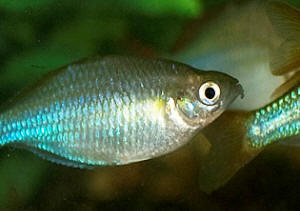
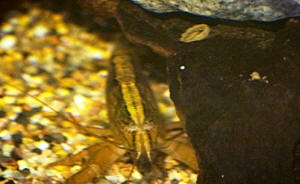 |
|
Re: Dwarf Neon Rainbowfish and
Atyopsis shrimp - disease questions 7/2/11
Sorry Crew,
One last question. I also have access to Paradise fish as another
alternative. Would one of these be too aggressive for my tank and
would the tank be too warm for it?
Thanks so much,
Duncan.
<It's unlikely you'll have success with a Common
Paradisefish, Macropodus opercularis; the males of this species
are especially aggressive, and yes, they do prefer unheated or
subtropical conditions. If you can find it, Macropodus concolor
is quite a bit less aggressive and can be kept with fast-moving
tankmates (such as Danios and many loaches) that appreciate
subtropical to low-end tropical conditions. Cheers,
Neale.>
Re: Dwarf Neon Rainbowfish and Atyopsis shrimp - disease
questions 7/2/11
Thanks so much for your prompt reply Neale, and most helpful (as
usual!).
<No problem.>
I'll try not to treat the tank if possible, as I'm scared
about what any medication might do to the Atyopsis shrimp.
<Quite so; copper-based medications in particular kill
crustaceans very quickly.>
As to your fish suggestions, they all look excellent! Just to
double-check, none of them will slowly nibble away at the
Atyopsis shrimp which are more or less defenceless, despite their
decent size?
<Shouldn't do. Those three Climbing Perch are basically
peaceful and the only danger they pose is simple predation --
they will eat fish they can swallow. In the case of Ctenopoma
acutirostre, that's fish up to about the size of a Danio.
Deep-bodied fish like Rainbows are generally safe.>
I'm guessing the rainbows will be fine. Plus my GH is 4 -
forgot to mention that in the last email. Should I just get a
single fish to add? And again to double-check any of the three
species will be O.K. in my 60L tank?
<Ah, no, the Ctenopoma acutirostre will need more than 60 l/15
gallons; the other two species would be fine, assuming you kept
just one male either alone or with one or two females. I forgot
to mention Trichopsis gouramis, of which there are several
species. Trichopsis pumila is sold as the Sparkling Gourami and
is very small, 2-3 cm, while the larger Trichopsis vittata is up
to 6 cm long and perhaps a bit less colourful, though it's
croaking abilities do make up for that! This second species would
be an
ideal size for use in community tanks (Trichopsis pumila is
rather small and does need extremely gentle, peaceful
tankmates).>
One of my LFSs is carrying Ctenopoma acutirostre at about SG$5.00
per fish, calling them a 'leaf fish', but I love the look
of the other two as well!
<They are quite neat.>
Oh, and by the way, back to the Atyopsis - one of them moulted 4
days ago and I left the shed skin in the tank for the pair of
them to eat away at, but they haven't seemed that interested
in it. Should I leave it in there or take it out?
<Yes, let the shrimp eat the moult if it wants, but after 24
hours you can remove it. Do dose the tank with iodine if you can
(marine aquarium iodine at 50% the quote dose works fine) or else
ensure you provide some iodine-rich foods, such as the foods
produced by JBK specifically for shrimps and crabs.>
Sorry for all the extra questions and thanks so much,
Duncan.
<Glad to help, Neale.>
|
|
Forktail Blue-eye with Columnaris? 3/8/11
Hi Crew
<Dr. N.>
I can't believe this - after turning on the lights of the
tank, I've noticed that one of the Forktail Blue-eyes
Pseudomugil furcatus I got from Wildwoods has white fuzz around
one fin and that fin is not really moving.
<Mmm>
He is also isolating himself from the others. Now, I will call
the shop tomorrow but I really don't want to drive a good 20
miles just to replace one fish. I have Fungol 2 antibiotics and
Ektol Fluid. I understand both treat Columnaris (I'm assuming
that is what it is). Should I go ahead and treat it in a hospital
tank (I usually change the water twice a day and replace the
medication to keep the nitrites at zero). I'd appreciate your
thoughts (poor little fella!)
<Oh, w/o live microscopic examination (and possibly a bit of
stain-work)
I'm hesitant to suggest administering either of these here...
Please read this bit re: http://www.fishvet.com/columnaris.htm
Really appreciate your ongoing support.
Dr Patrick Nunn
<I'd do the water changes suggested, NOT mix in any other
livestock... and be patient for now. Bob Fenner>
Forktail Blue-eye with funny fin 3/8/11
Dear Crew
<Dr. Pat>
re. email yesterday about Forktail Blue-eye with funny fin just
purchased from shop.
I've attached some pics (the best I can take considering
their size and speed of movement without using a flash!)
What do you think? At first I thought Columnaris but as I am sure
you will know all too well, diagnosis can often be tricky.
Hopefully you will see that the fin is always at odds with the
other and that it is white in colour and has a white area around
the fin. He appears to be eating fine.
<I don't think this is an infection per se, but very
likely a "whitening out" of the left pectoral from a
physical injury... Perhaps a "whack" from a net while
being collected for movement>
I have various medications here that I prefer to use (I avoid any
Interpet products as these do not work for me). I have JBL
Furanol 2, Fungol, Ektol Fluid, Ektol Crystal, Punktol ultra and
I can purchase JBL Oodinol if you think it might be velvet
(although it is not yellow in colour). I have plenty of salt
crystals and vitamins and a hospital tank with an air pump.
What would you recommend at this stage?
<Again, simply patience. All these treatments have their
place, but also downsides. It is my long-studied and observed
opinion that not treating in many to most cases is better than
blindly doing so>
Would you recommend any particular foods for these little lovely
fellas generally?
<A good, fully-nutritious pellet (Spectrum, small diametre) or
dried staple, with periodic (esp. for breeding conditioning)
frozen/defrosted (of small size) crustacean and/or insect based
supplement>
Just for completion sake, the five are currently in a 115 ltr
tank (10 month old) heavily planted with aeration/pump/filter.
Also in the tank are two male dwarf honey Gourami, four home bred
flame tail guppies, four neon tetra incorrectly sold to me for my
water type, and a few cherry shrimp and tiny snails. Ammonia is
zero, nitrite is zero, nitrate about 10ppm, Ph around 8, water is
hard (London). Currently feeding flakes, sometimes frozen brine
shrimp and the odd pea / cucumber piece. 30-50% water change
every week.
Many thanks
Dr Patrick Nunn
<As many welcomes. BobF>
|
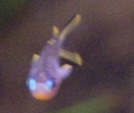
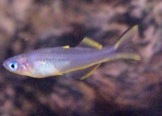 |
|
Re: Forktail Blue-eye with funny fin
3/9/11
Thanks Bob!
<Welcome>
The little fella with the funny fin, it looks about the same
today, hard to tell really but keeping a close eye.
<Takes weeks to resolve>
You say that it is very likely a "whitening out" of the
left pectoral from a physical injury... Perhaps a
"whack" from a net while being collected for movement.
Will it recover? Is there anything I can do to aid recovery?
<Yes, and not really other than good care>
I can't find any info on fish wounds of this nature in any of
my literature or online.
Many thanks to your team!
Dr Patrick Nunn
<Again, welcome. BobF>
Re: Forktail Blue-eye with funny fin --
3/9/11
Bob
<Dr. P>
The white area is definitely changing - a white raised surface
spreading around his body. I've put him in a tank on his own
with water from the original tank, heater (24c) and air stone. Do
you think I should medicate now with broad spectrum
antibiotics?
<Perhaps. Do monitor for cessation/loss of biological
filtration... be ready to augment nitrification or do large water
change outs>
He is definitely less active than when I got him. Sorry for so
many questions....
many thanks
Dr Pat
<No worries. BobF>
|
Turquoise Rainbowfish - sickness w no visible issues, or
data 2/5/11
I hope you can help me. I had two Turquoise Rainbowfish in a 30 gallon
tank
along with 5 other rainbows (2 Boesemanni and 3 "standard")
and a few tetras.
<Mmm, many small Characoids "like" quite different water
quality than standard Rainbowfishes... harder, alkaline, lower
temp...>
The Turquoise Rainbowfish were thriving for several month then a couple
weeks ago the female started swimming vertically and, although eating,
was getting thin. It seemed like she had "brain damage" the
way she was behaving. There were no other symptoms besides the erratic
swimming, no fungus or sores. She ended up dying. A week later my male
went through the same thing and he died within 3 days of showing
symptoms.
My remaining fish are fine, only my Turquoise Rainbowfish were
affected?
Could you please tell me what may have happened? I miss them and would
like to replace them but want to make sure I fix whatever the problem
was before trying again.
<Mmm, can't tell from the data presented... what re water
quality tests? Maintenance, gear?>
Thank you,
Christine
<Do please have a read here:
http://wetwebmedia.com/FWSubWebIndex/rainbowsysf.htm
and the linked files re this group of fishes above... and the species
of Tetras you keep requirements. Bob Fenner>
Neon rainbow 3/4/11
Hi,
1 week ago purchased 4 neon rainbows as the first inhabitants of my
newly cycled 180 litre tank. When I got them home from the shop I
noticed that one of them had a dark purple/brown patch on one side of
it's face extending about half way down one side of it's body.
At first I though it may just be a birthmark or bruise but then today I
noticed one of the others seems to have the same kind of spot
developing on her face as well.
I searched your articles and found that someone else had asked about a
similar problem in their Neons in August last year and my fish looks
similar to the fish in their photo. The patch on my neon however
definitely seems to be under, or part of, the skin rather than a
coating on it. There is no swelling or raised area. No one seemed to
have a definitive answer at the time and I was wondering if you ever
found out what it was or if/how they ended up treating it? Or could my
problem be genetic as I assume my fish are probably sisters? My tank
has 0 ammonia 0 nitrite and about 5 nitrate. PH is around 7. Aside from
the marking, all 4 fish seem fine and are eating and swimming
normally.
Thanks for taking the time to read my question, Karen
<Hello Karen. Neon Rainbowfish -- Melanotaenia praecox -- are a much
different species to Neon Tetras -- Paracheirodon innesi. When Neon
Tetras start to lose colour it's often related to a syndrome called
Neon Tetra Disease, which is usually attributed to a parasite known as
Pleistophora hyphessobryconis. Specifically, their normal colours fade
to grey or white.
Rainbowfish, by contrast, do sometimes develop these odd dark patches
on their flanks. Sometimes they're caused by physical damage, the
nerves that control the colour cells in the skin are damaged, e.g., by
a frightened fish throwing itself into the hood. But they may also be
related to viral infections, birth defects, and who knows what. Without
a photo it's hard to say what the problem is, but if it's a
case of a healthy fish just display an odd patch of colour, I'd
tend towards the nerve damage explanation, and wonder why two fish have
now done this. 180-litres (about 50 US gallons) should be ample for
Melanotaenia praecox, but do check for aggressive tankmates, and of
course, if water quality isn't perfect, fish tend to be more jumpy
than normal, so things like the aquarium lights coming on in a dark
room can cause remarkable fits of hysteria. Cheers, Neale.>
Re: Neon rainbow 3/11/11
Thanks Neale, The dark patches have been steadily fading and today the
seem to have disappeared entirely. They were a little skittish when I
first put them in the tank so maybe that was when they got hurt. They
all seemed to have settled in just fine though. Thank you so much for
your answer, I do tend to be a bit of an anxious mother and it's
nice to have someone to ask when you're not sure what is going on.
Karen.
<Sounds promising. So whatever the problem, perhaps it's
clearing up by itself, something that happens more often than many
aquarists suppose.
Holding off the medication, and instead optimising aquarium conditions
and diet, can sometimes effect the most remarkable turn-arounds.
Anyway, happy to listen, and good luck! Cheers, Neale.>
Boesemanni rainbows struggling 12/23/10
I have a 100g community tank with five boesemanni rainbows, 4
turquoise rainbows, 3 average size Bala sharks, loaches, Plecos
and a rainbow shark.
I had 2 male, 2 female boesemanni.
All has been well since February.
I recently added two rams, and one boesemanni rainbow. This brings
them up to 5. I know not the sex of this rainbow, but it was
brightly colored blue/orange. It was much more colorful than my
females, but
much smaller than my other males. There is a lot of "mating
chasing" in my tank when only lit with ambient light (dusk
and dawn lighting etc.) Males chase off males. Males chase
females.
Well, it up and died last week. I initially wrote this off as a
fluke. Possibly stress of being chased and new environment.
Nothing visibly wrong with the fish.
Then over the weekend, one of the females died. Her body looked
horrid. Peeling scales, damaged fins and chunk missing out of the
tail - while she was alive. Nasty.
Then Monday, I noticed the other female had a white-tipped nose.
And she wouldn't eat.
Tuesday she died.
Tuesday night, I notice the two boesemanni males are not eating.
Uh oh. One of them has a damaged side and nice fungus patch there
(whattt?) I moved them into quarantine.
<... too late for quarantine>
I speculate the real problem among the boesemanni is stress, but
its not certain.
<More likely biological disease. Pathogen>
Its hard to explain why none of the other species in the tank are
affected by what is killing the boesemanni. The deaths are also
inconsistent. The first had nothing visibly wrong. The second
was
damaged beyond reason. The third had only a white tipped nose.
And none had a big fungal patch like the one male.
<There are "group specific" (Rainbow) diseases... or
ones that there much more susceptible to. Have seen what you have
quite a few times... Very catching, and quick to kill all
Melanotaeniids. See WWM re: http://wetwebmedia.com/FWSubWebIndex/rainbowdisf.htm
STAT! Bob Fenner
Re: Boesemanni rainbows struggling 12/23/10
Not to flood - surprisingly, the one in QT upside down is...
still alive.
I'm seeing a connection
First: Died without me seeing, upside down in the brush, no way
to verify how.
Second: Died a horrid gross death with a lot of damage and decay
and discoloration and swelling
Third: White tipped nose, slight discolored, swollen, upside down
in QT for 24 hours before dying
This one: Severely discolored, swollen, upside down in QT all day
now, white gunk on side, not expected to live long. This guy is
severely....up-side-down
<... Read, act. BobF>
Re: Boesemanni rainbows struggling
12/23/10
Actually, they do have something in common.
<Oh?>
Near death, swimming upside down and almost no control of
swimming.
<BobF here... There is something very wrong here>
This one in pic, has the white gunk spot as shown. I cant get
closer though, sorry.
So, that makes 1 unknown, 2 females, and soon this male here.
=(
<I suspect a protozoan or Fluke infestation, and would QUICKLY
treat for both. Either a dip and move (to avoid reinfestation) in
a toxic bath (formalin based likely) and/or a multi-pronged
attack w/ Metronidazole and an Anthelminthic. Do read re (NOW)
these on WWM:
http://wetwebmedia.com/FWSubWebIndex/fwmaintindex.htm
Bob Fenner>
Re: Boesemanni rainbows struggling, repro. beh. obs. 12/24/10
Comment on FAQ link:
http://wetwebmedia.com/FWSubWebIndex/rainbowdisf.htm
"Two days ago I noticed one the rainbows swimming almost
vertical with head down and tail up. He is also using his whole
body in a wiggly motion as he swims. There are no spots or marks
on him and he is eating fine. At times he looks like he
doesn't know where he is swimming to because he almost bumps
into other fish."
Thinking this is perfectly natural part of mating. My males all
do this, while intensifying their colors and displaying a big
orange stripe down their head. Then they chase the females as
such, lowering their nose to the ground tail up to
"show" the lady his big orange stripe and attract her
interest (though most of my males are harshly rejected lol) They
do it most during times where the tank light is off, but the room
is lit (dusk/dawn lighting effect)
<Ahh, thank you for this input. Bob Fenner>
|
|

|
White Patches/Swelling on Australian Rainbowfish's
Eyes & Subsequent Blindness, Neale's go 8/21/10
Hi,
<Hello,>
I have an Australian Rainbowfish that I thought would've died a
long time ago because of the multiple health problems it has over the
past year. I originally asked for your advice back on January 9th of
the year about open body sores this fish got after having gotten Popeye
twice.
<Oh dear.>
The newest issue is this poor fish's eyes. They are both swollen,
covered with nasty white patches that are really thick and lumpy. On
one eye, the white of the eye looks brown (like dried blood) in certain
areas.
<Usually caused by the environment if both eyes are swollen. Do read
here, re: symptoms and treatment:
http://www.wetwebmedia.com/fwsubwebindex/fwpopeyefaqs.htm
http://www.wetwebmedia.com/fwsubwebindex/FWEyeTrbInfDisF.htm
Pop-eye is treatable, and can get better, but it is admittedly
difficult to treat.>
The fish is definitely blind. He runs into everything, he hasn't
eaten in probably 2+ weeks, so I'm not sure how he's even
alive.
<Fish can last quite some time without food.>
I've checked our water quality and our levels always come back on
par.
<Meaning what? For standard Australian as opposed to New Guinean
Rainbowfish, water chemistry needs to be around this: 8-15 degrees dH,
pH 7-8. The water temperature should be towards the cool end, 20-24
C/68-75 F being about right. As you'd expect, ammonia and nitrite
need to be zero, but Rainbowfish also need low nitrate levels and lots
of oxygen. Aim for nitrate below 40 mg/l and preferable below 20 mg/l;
do regular water changes; and under- rather than overstock the
tank.>
All of our other fish our completely healthy. I don't know what to
door for this poor guy. I feel like he's going to die soon, but
this seems to be the fish that is incapable of death.
<Well, that can be fixed. Read here:
http://www.wetwebmedia.com/euthanasia.htm
for humane methods of euthanasia.>
We have treated the whole tank (55 gallon) with a round of API
Pharmaceuticals' "Fungus Cure" and then we tried API
Pharmaceuticals' "Triple Sulfa" and then we tried just
leaving it alone.
<I see.>
The fish has gotten really bad and it looked like it had clear bubbles
on it, so tonight I moved it to a hospital tank with Tetra's
"Fungus Guard," thinking that the patches on the eyes are
fungus, and maybe the bubbles on the scales had to do with a fungus,
too. Although, the more I looked at the fish in the hospital tank, I
think he may have come down with a secondary Ick infestation. Needless
to say, this fish is not doing well at all.
<There's no obvious reason for one particular fish to suffer
from these symptoms, except to say that fish have varied genes just
like humans, and some are less resistant to disease and stress than
others. Review living conditions, make sure diet is appropriate, and do
your best to isolate this aquarium from any others until you're
comfortable that the trouble has passed. I'd imagine destroying
this fish humanely is the next step, but after that, check water
chemistry and temperature, review stocking and filtration, make sure
diet is balanced, and generally keep an eye on the other fish.
Don't add anything new for at least two months. See how the tank
settles down.>
What should we do? I hate that this poor fish is suffering like this. I
truly think this fish may just be genetically predisposed to these
health problems because it's not the water or the tank.
Thanks for any advice.
Heather Richardson
|
|

